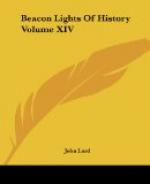The art of printing was known in China five centuries before it made its way to Europe. The Confucian classics having been engraved on stone to secure them from being again burned up, as they had been by the builder of the great wall, the rubbings taken from those stones were printing. It required nothing but the substitution of wood for stone and of relievo for intaglio to give that art the form it now has. The smallest scrap of printed paper in the lining of a tea chest, or wrapped about a roll of silk, would suffice to suggest the whole art to a mind like that of Gutenberg. In China it never emerged from the state of wood engraving. The “Peking Gazette,” the oldest newspaper in the world, is printed on divisible types, but they are of wood, not metal, more than one attempt to introduce metallic types having proved unsuccessful, for the want of that happy alloy known as type-metal. It is from us that they have learned the art of casting type, especially that splendid achievement, the making of stereotype plates, and, later, electrotype plates, by the aid of electricity and acid solutions. Chemistry, from which this beautiful art takes its rise, carries us back to China, for it was there that alchemy had its birth, as I have elsewhere shown.[4]
[Footnote 4: “The Lore of Cathay.” New York: Fleming R. Revell Co., p. 41.]
Man’s first desire is long life; his second, to be rich. The Taoist philosophy commenced with the former before the Christian era, but it was not long in finding its way to the latter. A powerful impulse was thus given to research in the three departments of science,—chemistry, botany, and geography. As in the case of gunpowder, the Arabs transmitted these discoveries to the West, and along with them the Chinese doctrine as to the twofold objects of alchemic studies,—the elixir of life and the philosopher’s stone.
From this double root sprang the chemistry of the West, which in no mean sense has fulfilled its promise by prolonging life and enriching mankind. In all these the West has performed the part of a nursing mother, but she has brought the nursling back full grown, and prepared to repay its obligation to its true parent by effective service.
Portuguese merchants made their way to Canton early in the sixteenth century, but it was not till the latter part of the century that Catholic missionaries entered on their grand crusade. In 1601 the Jesuit pioneer Matteo Ricci and his associates, impelled by religion and armed with science, presented themselves at the court of Peking. The Chinese had been able to reckon the length of the year with remarkable accuracy two thousand years before the time of Christ, but their science had made no headway. The missionaries found their calendar in a state of confusion, vanquished the native astronomers in fair competition, and were formally installed as keepers of the Imperial Observatory; and these missionaries supervised the casting of the bronze instruments which have since been taken to Berlin.




